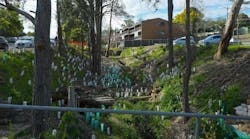On April 20, Waste Management Inc. and AbTech Industries Inc. announced a new agreement to provide stormwater services to municipalities in the US and Canada.
Waste Management, based in Houston, TX, provides waste management services throughout North America, including collection, transfer, recycling, and disposal services. AbTech Industries is an environmental technologies firm; one of its products is SmartSponge, a sponge-like material with polymers to filter, absorb, and solidify petroleum hydrocarbons and other pollutants from stormwater runoff. Under the agreement, Waste Management will become the exclusive waste and environmental services company distributor of SmartSponge in North America.
Forester Media spoke with representatives of both companies about what this new arrangement might mean for municipal stormwater programs.
Paul Pistono, Waste Management’s vice president of public sector solutions, says “We are working on a total stormwater quality management strategy that could comprise multiple services, from curbside collection to street sweeping to the installation and maintenance of stormwater systems and more. Because we are often entrenched and “˜omnipresent’ in the communities we serve, this is a natural evolution for us.”
Gordon Brown, vice president of corporate development with AbTech, notes “The municipal stormwater market is in a great state of flux right now. The regulations vary not only from state to state but also from municipality to municipality, across MS4s and NPDES permits. One of the key benefits that we can bring is a consistency in how to respond to those challenges so that each individual municipality doesn’t have to recreate it. It allows them to respond efficiently and much more quickly than if they had to go out and created these responses from scratch.”
Many cities already contract out parts of their stormwater program, particularly ongoing tasks like BMP maintenance or services like street sweeping, which the city might not have the staff or the equipment to provide.
In addition, some small NPDES Phase II permittees have banded together to share resources and avoid duplication of effort on requirements like public education campaigns or outreach programs.
The services Waste Management provides under this arrangement will be tailored for each municipal customer. Glenn Rink, AbTech’s president and CEO, says it’s important to understand each city’s critical needs, whether major or minor. “We’re looking to offer a custom solution that is available based on a city’s exact needs. It could be health, tourism; it could be a variety of issues.”
Pistono agrees: “We have learned that there is no “˜fits one, fits all’ solution for the municipalities we service.” He notes that the two companies have people who are well versed in stormwater regulations. “Cities can turn to us for assistance with their overall stormwater plans,” he says, or for smaller services with which the city might need help. “We feel that we complement municipal employee efforts and that we are an extension of the public works department.”
He says that although the initial pilot program is with municipalities only, AbTech has long been providing services to private customers as well, and if there is an opportunity down the road to provide stormwater service to private customers-for example, a homeowners association with stormwater facilities on its property-“we are happy to help.”
An interesting aspect of the technology involved is its disposal. SmartSponge, once used-perhaps installed in a drainage filter through which stormwater runoff flows-is a solid “brick” that possesses some energy value. Although it can be disposed of in a landfill as ordinary municipal solid waste, it can also be used as fuel to create energy in a waste-to-energy facility. As Brown explains, “The material has a tremendous porosity; it flows high volumes of water and collects the hydrocarbons and turns them into a solid, so that they cannot be washed off or squeezed back out. Depending on how much sediment and other components are in it, about 320 pounds of SmartSponge can create a megawatt of power.
“Few people have thought about harvesting hydrocarbons out of stormwater to be able to use it as fuel, whether in waste-to-energy facilities, cement kilns, asphalt plants, or those types of areas. You’re actually harvesting energy out of stormwater and using it as a fuel.”
The services will be offered first in parts of Florida, North and South Carolina, and eastern Canada. How quickly they move to other areas, Pistono says, depends somewhat on the receptivity of the municipalities that make use of the services first, but he expects that states bordering the ocean will be likely candidates in the near future.
About the Author
Janice Kaspersen
Janice Kaspersen is the former editor of Erosion Control and Stormwater magazines.


